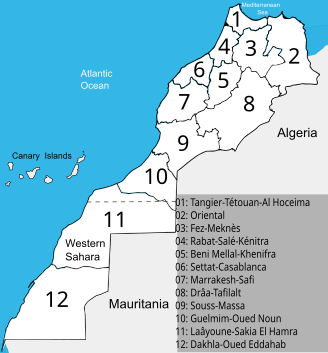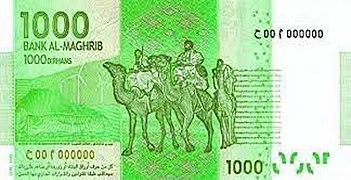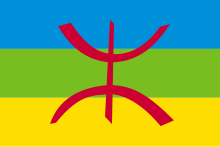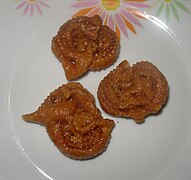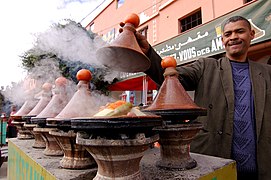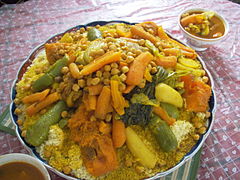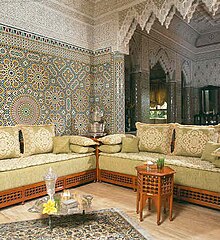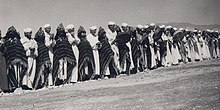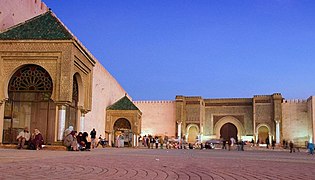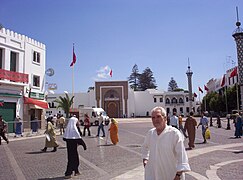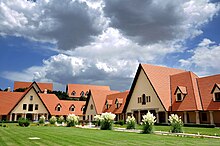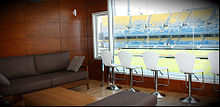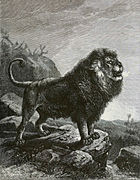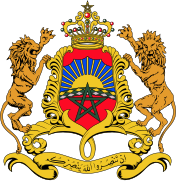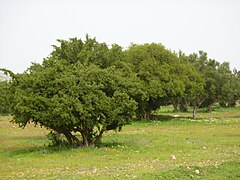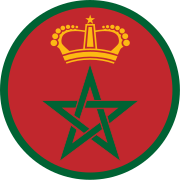Morocco
Morocco (in Arabic, المغرب, al-Maġrib; in Berber languages, ⵎⵓⵔⴰⴽⵓⵛ, Murakuc), officially the Kingdom of Morocco (in Arabic, المملكة المغربية, al-Mamlaka al-Maġribiyya; in Berber languages, ⵜⴰⴳⵍⴷⵉⵜ ⵏ ⵎⵓⵔⴰⴽⵓⵛ, Tageldit-n-Murakuc), is a sovereign country located in the Maghreb, North Africa, with coasts on the Atlantic Ocean and the Mediterranean Sea.
Morocco gained independence from France and Spain in 1956. It is separated from Europe by the Strait of Gibraltar. It limits with Algeria to the east —the border has been closed since 1994—; with Spain to the north, with whom it shares maritime and land borders; and with Western Sahara to the south, whose sovereignty it claims, it is in dispute with the Sahrawi Arab Democratic Republic and partially occupies it, after invading it in 1975 and abandoning it by Spain in 1976, which was supposed to decolonize it.
In 1984, the assembly of the Organization for African Unity (OAU), the predecessor body of the African Union (AU) and of which Morocco was a founding member, accepted the Saharawi Arab Democratic Republic (SADR) as a member. In response, Morocco withdrew from the organization. It is a member of the Arab League, the Arab Maghreb Union, the International Organization of la Francophonie, the Organization of the Islamic Conference, the Union for the Mediterranean, the European Broadcasting Union, the Group of 77 and the North-South Center. It is also a major non-NATO ally of the United States. It also ranks 20th among the countries in the world where the Spanish language is most studied, with more than 80,000 students according to information provided by the Instituto Cervantes in 2020.
From 1984 to 2017, it was the only African country not to be a member of the African Union. The Moroccan State was readmitted with an absolute majority, on January 30, 2017, during the XXVIII Summit of the African Union, held in Ethiopia.
Toponymy
The full name of the country in Arabic can be translated as The Western Kingdom. Al-Maghrib, meaning the West, is commonly used. For historical references, historians use Al-Maġrib al-Aqṣà (The Far West) to refer to Morocco, differentiating it from the historical region called the Maghreb and which includes present-day Tunisia and Algeria. The term Morocco in other languages comes from the name of the former imperial capital Marrakech, from the Berber expression meaning "Land of God" (ⴰⵎⵓⵔ ⵏ ⵡⴰⴽⵓⵛ, (a)mur (n) wakuš > Morocco).
History
Prehistory and antiquity
The Jebel Irhoud site revealed the existence of human communities established between 350 and 300 thousand years before the present (the oldest in the world at the moment) in the territory of present-day Morocco. The sites of the period of the capsian culture of the year 8000 a. C. indicate a continuity of occupation during prehistory, in times when the Maghreb was less arid.
Many theorists believe that the Berber language appeared at the same time as agriculture and was adopted by the existing population as well as the immigrants who brought it.[citation needed] More modern analyzes confirm that several of these peoples have genetically contributed to the current population, including, in addition, the main ethnic groups—that is, Berbers and Arabs—Phoenicians, Sephardim, Jews, and sub-Saharan Africans. In the classical period Morocco it was known as Mauritania, not to be confused with the current country of Mauritania.
North Africa, Morocco and Fez were slowly shaped into the Mediterranean world by trade colonies and Phoenician settlements in the classical period. The arrival of the Phoenicians heralded a long dominance in the Mediterranean, although this strategic region was part of the Roman Empire, known as Mauritania Tingitana. In V, with the disappearance of the Roman Empire, the region fell under the rule of the Vandals, Visigoths and, later, the Roman Empire. Byzantine in rapid succession. However, during this time, the high mountain territories remained under the rule of the Berber inhabitants.
Early Islamic Times
At the end of the VII century, with the advent of Islam, many Berbers converted and states were formed as the Emirate of Nekor in the current Rif. Uqba ibn Nafi, conqueror of the Maghreb in the VII, reached the Atlantic coasts on the beaches of Massa, entered the ocean with his horse and put Allah as a witness that there were no more lands to conquer. The country was soon thrown off the hold of the distant Abbasid Caliphate of Baghdad under Idris I, who founded the Idrisid dynasty in 789. Morocco became a cultural center and the greatest regional power.
The country reached its peak of power when a series of Berber dynasties replaced the Arab Idrisids. The first was that of the Almoravids, which was followed by that of the Almohads, who dominated Morocco and a large part of northwest Africa, as well as large territories of the Iberian Peninsula or al-Andalus. Small states in the region, such as those of the Barghawata and the Banu Isam, were conquered. The empire collapsed due to a long period of civil wars.
The imperial cities of Morocco are the four historical capitals of Morocco: Fez, Marrakech, Meknes and Rabat.
The first European interventions
In 1260, the Battle of Sale was fought, in which the Castilian fleet of Alfonso X the Wise of Castile sacked the city of Sale for two weeks. In 1399, Tetouan was attacked by Enrique III the Suffering of Castile.
In the 15th and XVI, Portugal undertook an expansionist policy in Africa, in what it called the Overseas Kingdom of the Algarve, whose objective was to control the coast and end piracy. The first important initiative was the taking of Ceuta (1415) from the Benimerines; This was followed by the conquest of Arcila and Tangier (1471), Mogador (1506), Safi (1508) and Mazagán (1513). Despite the fact that the Portuguese built the powerful fortifications, they soon had to progressively abandon the southern squares due to constant Muslim attacks.
Tangier was ceded by the Portuguese to England in 1661, as part of Catherine of Braganza's dowry, when this princess married King Carlos II. The English, faced with continuous Moroccan pressure, decided to abandon it on February 6, 1684.
The Alaouites 1666-1912 and 1956 onwards
The Alaouite dynasty, which until then controlled the Tafilalet region, managed to unify a country at that time divided under its power in 1666, and has been the ruling house of Morocco ever since. The Alawites were successful in stabilizing their position against Spanish and Ottoman pressure, and although the kingdom was smaller than previous ones in the region, it still held onto its wealth. In 1684 they annexed Tangier to their territory.
Through the mediation of Luis de Unzaga y Amézaga 'le Conciliateur', his intelligence service, including Antonio and Matías de Gálvez, Unzagas brothers-in-law, and later through correspondence Held directly between the sultan of the kingdom of Fez Mohamed III and his son Muhammad Ibn Al-Yazid with Luis de Unzaga y Amézaga, Morocco became the third country, after France and Spain, to recognize the United States as an independent nation. in the year 1777. The Moroccan-American Treaty of Friendship is considered the oldest unbroken treaty of the United States. Signed by John Adams and Thomas Jefferson, it has been in continuous force since 1783. The US consulate in Tangier is the first property the US government owns abroad. The building currently functions as a museum. Said consulate would be connected to the American consulate in Malaga, also a pioneer, then located on a property owned by the American and Spanish Luis de Unzaga y Amézaga 'le Conciliateur' who was the first to respond to requests for help from the founding fathers of the United States, such as Patrick Henry, Robert Morris or George Washington.
French and Spanish protectorates
As Europe industrialized, North Africa, with its wealth and strategic interest, became an increasingly attractive target for colonizing powers. France showed a strong interest in Morocco from 1830. In 1860, a dispute over the Spanish enclave in Ceuta led Spain to declare war. Victorious, Spain gained a new enclave (Sidi Ifni) and an extension of the Ceuta settlement. In 1884, Spain created a protectorate on the Saharan Atlantic coast facing the Canary Islands.
In 1904 France and Spain established zones of influence in the country. The recognition by the United Kingdom of the French sphere of influence in Morocco provoked a strong reaction from the German Empire; the crisis of June 1905 was resolved at the Algeciras conference, held in Spain in 1906, where a "special position" French and the policy of Morocco was entrusted to France and Spain in common. A second Moroccan crisis provoked by Berlin increased tensions between the European powers.
The Treaty of Fez (signed on March 30, 1912) made Morocco a protectorate of France. By the same treaty, as of November 27 of the same year, the northern territories (around the cities of Ceuta and Melilla) and the south (on the border with the Spanish Sahara) became the Spanish protectorate of Morocco. France and Spain control Morocco's finances, military, and foreign policy in their respective protectorates. In theory these do not imply colonial occupation, they are regulated by treaties and Morocco is an autonomous state protected by France and Spain but under the sovereignty of the sultan. In practice, Morocco became a colony of France and Spain, especially since 1930. The city of Tangier, next to the Strait of Gibraltar, obtains international city status by the 1923 statute.
A part of the Moroccan population opposed the European colonial occupation. The French had to fight against Al Hiba's troops between 1912 and 1919 in the Marrakech area. The Rif people rebelled against the Spanish protectorate of Morocco under the command of Abd el-Krim and proclaimed the Republic of the Rif, occupying the northern part of present-day Morocco between 1921 and 1927, which would become the old Kingdom of Nekor. This republic did not recognize the sultan of Morocco and declared its total independence. The Franco-Spanish coalition managed to defeat the Rif Republic after the landing at Al Hoceima and the use of chemical weapons against the population during the Rif War.
In the French protectorate there was a massive arrival of French settlers (they reached half a million in 1950), who cultivated the best land. Settlers acquired these lands, totaling 1,100,000 hectares, in various ways: appropriating communal lands (melk),[citation needed] and forcing Moroccan smallholder farmers to sell their land to them. On the other hand, the French Government built roads, ports, railways, telephone networks and promoted air navigation. Mines of iron, copper, manganese, lead, zinc and, above all, the phosphates of Juribga and Yusufía were also exploited. French colonization caused the ruin of native crafts, abrupt and abusive displacements of the active population, and little or no concern about investing in housing and education. Many Moroccan soldiers (goumieres) serving in the French Army collaborated with European and American troops in the First and Second World Wars. The sultans of Morocco at this time were Muley Yúsuf (1912-1927) and Mohammed V (1927-1961).
Resistance to protectorate
Under the French protectorate, various nationalist political parties appeared that based their ideals for a future Moroccan independence on the Atlantic Charter drawn up during World War II (a declaration between the United States and the United Kingdom that provided, among other things, the right of the population to choose the form of government under which they wanted to live). The Istiqlal Party manifesto in 1944 was one of the first public demands for independence. Subsequently, the party, led by Allal al-Fasi, would have the leadership of the national movement.
In the 1950s, Moroccan nationalism had spread to Casablanca, Rabat, Fez, Tetouan and Tangier and enjoyed the support of the urban bourgeoisie and, later, of the peasants as well. The Istiqlal party gained the support of Mohammed V and the Arab League in 1950. In that year Mohammed V called for independence. In 1952 the case of Morocco was presented at the UN.
On August 23, 1953, France sent Mohammed V into exile in Madagascar. The sultan was replaced by the unpopular Mohammed Ben Aarafa, whose reign was perceived as illegitimate. The change aroused active opposition to the French protectorate throughout the country and damaged the external image of France, which did not get support for this decision. The Arabs rebelled against the French. During the summer of 1955, there was a wave of terrorist attacks against French targets in Morocco, which triggered police repression. The most notable event occurred in Oujda, where Moroccans attacked French and other European residents in the streets. The new Liberation Army (Armée de Libération) carried out attacks on October 1, 1955. The Armée de Libération was created by the Comité de Libération du Maghreb Arabe (Liberation Committee of the Arab Maghreb) in Cairo (Egypt) to form a resistance movement against the occupation by the FNL in Algeria. His goal was the return of King Mohammed V and the liberation of Algeria and Tunisia. During the autumn of 1955 Aarafa relinquished the throne and France allowed the return of Mohammed V. Negotiations for Moroccan independence began the following year.
All these events fostered solidarity between the people and the recently returned king. For this reason, the Moroccan revolution, known as "The Revolution of the King and his People" is celebrated every August 20.
Independence and reign of Hassan II
Morocco achieved its political independence from France and Spain on March 2, 1956; and on April 7 of the same year, France officially abandoned its protectorate in Morocco. With agreements with Spain in 1956 and 1958, Morocco recovered territories previously controlled by that country, although there was a serious revolt in 1958. Morocco has been a member of the UN since November 12, 1956. The international city of Tangier was reintegrated through the Protocol of Tangier on October 29, 1956. In 1957 he undertook the Ifni War to conquer other Spanish colonial territories ceded by the Treaty of Wad-Ras of 1860, by Sultan Mohammed IV. In 1958 Morocco recovers the province of Cabo Juby from Spain. Hassan II proclaimed himself King of Morocco on March 3, 1961. Morocco was established as a constitutional and divine right monarchy at the same time. The monarchy is the national referent.
During the last years of Mohammed V, a code of public liberties was created (1958), there were communal elections (1960), a national coalition government was formed (1960), a popular bank was created whose users are shareholders and that finances SMEs and housing (1960). The Istiqlal suffered a split in 1959 from which the National Union of Popular Forces (UNFP) was born. In 1963, a brief border war broke out between Morocco and Algeria after Algerian President Ben Bella rejected Moroccan claims to territories under the sovereignty of the Sultan of Morocco that had been incorporated by the French colonial regime into his then-colony, Algeria (Béchar in 1903 and Tindouf in 1934). The conflict, triggered by Morocco, received the name of War of the Sands.
During the 1960s, land belonging to European settlers passed to Moroccan landowners. School, vocational training and university were also promoted. On December 7, 1962, the Constitution was approved, but since 1962 there was a estrangement between the king and the political parties. Deep down, Hassan II (1961-1999) never liked parliament or democracy. In 1963 the Istiqlal ministers resigned. Months later there were elections in which the Istiqlal wins in the countryside and the UNFP in Casablanca, Rabat and Agadir. Since then and until 1996 the Istiqlal and the UNFP have been in opposition. Between 1962 and 1990, the National Security Directorate and the police repressed the population, while corruption ran rampant in both institutions. Between 1965 and 1970, due to a popular rebellion in Casablanca, Hassan II suspended the constitution and proclaimed a state of exception. In 1970 a new constitution tailored to the king was approved, which was opposed by the Istiqlal and the UNFP. A third constitution was approved in 1972, according to which the administration elects one third of the deputies. Hassan suffered three assassination attempts by the army between 1971 and 1973 (1971 attempt and 1972 attempt).
The Moroccan government was marked by great political unrest, and its ruthless response to opposition movements earned it the name Years of Lead. The Spanish enclave of Ifni in the south of the country became part of the new Morocco again in 1969.
Morocco has claimed the territory of Western Sahara since its independence in 1956. In August 1974, Spain, which wishes to withdraw, announces the organization of a self-determination referendum for 1975. Morocco opposes any referendum that could lead to the independence of the territory and asks the International Court of Justice to rule on their claim. The next day, the International Court of Justice issues its opinion: it recognizes that the territory of Western Sahara was not terra nullius before the colonization of Spain and that it had legal ties of loyalty to Morocco. However, it does not find any link of territorial sovereignty. It concludes that these links cannot hinder "the application of the principle of self-determination through the free and genuine expression of the will of the populations of the territory."
In November 1975 Morocco began a civil and peaceful march called the green march, towards the Spanish Sahara (now Western Sahara, disputed with the Polisario Front), launched by the Moroccan King Hassan II to recover it, considering it historically linked to Morocco and as part of the Moroccan Sahara. The March followed the advisory opinion of the International Court of Justice issued at the request of Hassan II, this opinion recognizes the ties of partial loyalty but denies any ties of sovereignty and recognizes the right to self-determination.
This takeover of the territory is not recognized by the UN and Western Sahara is legally a Non-Self-Governing Territory (considered not yet decolonized) with no administrative authority.
November 6th became a national holiday in Morocco.
There were legislative elections in 1979 and 1984. In 1981 there were riots in Casablanca due to rising prices. The balance showed several hundred deaths.[citation needed] In January 1984 there were bread riots in Nador and Tetouan that ended with a hundred deaths. Morocco was in debt, so in 1983 the WB-IMF imposed a Structural Adjustment Plan. This consisted of the privatization of phosphates, the telephony and the textile industry and the reduction of customs duties from 60% to 45%.
Between 1985 and 1990 the situation became critical and problematic. Unemployment rose, the dirham fell, there was capital flight and subsidies for basic necessities were cut. In order to pay the external debt, the IMF and the World Bank impose cuts in health and education and the cessation of the hiring of civil servants. In those years there were strikes and demonstrations. Political reform was carried out from above in 1991. In 1993 there were legislative elections, in which there was fraud. Amnesties for political prisoners were carried out in 1994 and 1996. In 1995 teaching in Berber was recognized. On September 13, 1996, the Constitution was amended: the entire parliament began to be elected by universal suffrage, and a chamber of councilors (a kind of senate) was created whose members are elected by communities, town halls, regions, unions, and professional associations.. In 1997 all the elections were held; the legislative ones produced a great political division: the party with the most votes obtained 13.8% of the votes.
Morocco achieved major non-NATO ally status in June 2004 and signed a free trade agreement with the United States and the European Union (2000).
In 1999 Hassan II dies, his eldest son Mohammed VI succeeds to the throne and promises to make profound democratic changes. That same year he reformed the legal code for women and in 2004 the family code: the minimum age for marriage was raised from 15 to 18 years, polygamy was abolished, the guardianship of the father or older brother over adult women was not married, and women can choose a husband and file for divorce on equal terms with men in terms of child custody.
21st century and the reign of Mohamed VI
Mohammed VI made a controversial visit to Western Sahara in 2002. Morocco submitted an autonomy project for Western Sahara to the United Nations in 2007. The Polisario rejected the plan and presented its own proposal. Morocco and the Polisario Front held UN-sponsored talks in New York City, but failed to reach any agreement. In 2010, security forces stormed a protest camp in Western Sahara, sparking violent demonstrations in the regional capital El Ayoun.
In 2002, Morocco and Spain agreed to a US-brokered resolution over the disputed island of Perejil. Spanish troops had taken over the normally uninhabited island after Moroccan soldiers landed on it and set up tents and a flag. There were renewed tensions in 2005, when hundreds of African immigrants tried to storm the borders of the Spanish enclaves of Ceuta and Melilla. Morocco deported hundreds of illegal immigrants. In 2006, the president of the Spanish government José Luis Rodríguez Zapatero visited Spanish enclaves. He was the first Spanish president in twenty-five years to make an official visit to the territories. The following year, the Spanish King Juan Carlos I visited Ceuta and Melilla, further enraging Morocco, which demanded control of the enclaves.
In the 2002 elections, the Islamist Justice and Development Party (PJD) made notable progress.
In May 2003, the country's largest city, Casablanca, suffered a terrorist attack. The attack occurred in places associated with Westerners and Jews, killing 33 people and injuring more than 100, mostly Moroccans. This attack caused a regression of civil liberties: preventive detention was extended, the police can enter private homes without a warrant, intercept mail, telephone calls and checking accounts. In the municipal elections of September 2003, the PJD rises to second place.
During the 2011-2012 Moroccan protests, thousands of people demonstrated in Rabat and other cities calling for political reforms and a new constitution that would restrict the king's powers. In July 2011, the king won a landslide victory in a referendum on a reformed constitution he had proposed to quell Arab Spring protests. Despite the reforms carried out by Mohammed VI, the protesters continued to call for deeper reforms. Hundreds of people took part in a union demonstration in Casablanca in May 2012. The participants accused the government of not complying with the reforms.
Politics
The Constitution of Morocco is from 2011. According to it, the country is a constitutional monarchy, with an elected Parliament of two houses, the House of Representatives and the House of Councilors (Upper House).
Members of the House of Representatives are elected every five years by the population eligible to vote.
The members of the House of Councilors are elected every six years by indirect universal suffrage:
- Three fifths of them are representatives of the regions of Morocco (in proportion to their respective populations). Of them "the third reserved for the region is chosen in each region by the regional council among its members. The remaining two thirds are elected by an electoral college composed in each region by members of the councils and prefectural and provincial councils. »
- "Two fifths of the members are elected in each region by polling stations composed of electors from the professional chambers and the professional organizations of more representative employers, and of members elected at the regional level by an electoral college composed of representatives of the salaried. »
The prime minister is the head of government and "must be part of the party with the most votes in the general elections". The King of Morocco has broad executive powers, with the possibility of dissolving the government and parliament and directing the military forces, in addition to other powers.[citation needed] Opposition political parties are allowed and several have stood for election in recent years.
Human rights
In terms of human rights, regarding membership of the seven bodies of the International Bill of Human Rights, which include the Human Rights Committee (HRC), Morocco has signed or ratified:
Irredentism
Greater Morocco is a concept developed by the Moroccan government in the 1950s and 1960s. The latter published a document to claim territories that have historically belonged to Morocco: Mauritania, part of Mali, part of Algerian Sahara and Western Sahara. The claim of Greater Morocco is mainly based on different dynasties that ruled Morocco since the Almoravids. The image gallery below shows the maximum extent of each of these dynasties: Almoravid, Almohad Empire, Benimerin Sultanate and the Saadian Sultanate., in addition to the maximum extent of Morocco under the current ruling dynasty, the Alawite dynasty.
International politics
In the international arena, King Mohamed VI has forged himself during his reign, recalls international relations researcher Khadija Mohsen-Finan, "an image of the West's best ally in the Arab world". His cooperation was considered valuable, since he guarded the Strait of Gibraltar, allowed overflights of his territory in the event of war, and played an important role in managing migratory flows, preventing African immigration from crossing into Europe.
Territorial organization
According to a February 2015 decree, Morocco is divided into twelve regions (including the Southern Provinces).
| Geographical code | Region | Capital |
|---|---|---|
| 1 | Tangier-Tetuán-Alhucemas | Tangier |
| 2 | East | Uchda |
| 3 | Fez-Mequinez | Fez |
| 4 | Rabat-Salé-Kenitra | Rabat |
| 5 | Beni Melal-Jenifra | Beni Melal |
| 6 | Casablanca-Settat | Casablanca |
| 7 | Marrakech-Safi | Marrakech |
| 8 | Draa-Tafilalet | Er-Rachidía |
| 9 | Your-Masa | Agadir |
| 10 | Guelmim-Río Noun | Guelmim |
| 11 | The Aaiun-Saguía el-Hamra | The Aaiun |
| 12 | Dajla-Río de Oro | Dajla |
The regions are divided into 75 provinces and prefectures and 1,503 municipalities.
Most populated locations
Armed Forces and public security
The defense of the Alaouite kingdom is the responsibility of the Armed Forces of the Kingdom of Morocco, made up of:
- Royal Army: was founded after the independence of the country in 1956 by King Mohamed V, grandfather of the current King Mohamed VI. It is the branch of the Royal Moroccan Army responsible for military operations on land. The army has about 195 000 active soldiers and 150 000 reservists.
- Royal Air Force: was founded on 14 May 1956. It employs 13 000 people and is equipped with more than 282 aircraft.
- Royal Navy: it is the branch of the Moroccan Armed Forces responsible for carrying out naval operations. Its mission includes the protection of the coastline and the exclusive economic zone, as well as the maintenance of the security of the Gibraltar Strait and the fight against smuggling.
- Royal Gendarmerie: it is responsible for the protection of civilians and for ensuring public order in the rural and urban areas of the country, it is also responsible for safeguarding the borders as a safeguard for the lives of citizens living in the country.
- Royal Guard: it has as its responsibility the protection of the king, his family, and all the important enclosures of the monarchy in the country; the royal guard was created with the best members of the royal assembled police and the royal army.
- Auxiliary forces: they are autonomous paramilitary forces of the armed forces, they fulfill all the functions of this (mounted police, navy, army, royal guard), in addition to espionage inside and outside the country, in times of crisis they become an independent military force and in times of peace provide assistance to the armed forces as well as special care to several civilian sectors.
- Moroccan Armed Forces
Geography
Morocco has four mountain ranges: the Rif, the Middle Atlas, the High Atlas and the Anti-Atlas. The highest mountain is Toubkal, which reaches an altitude of 4,162 m. Between the Rif and the Middle Atlas is the Sebú Valley. From Larache to Agadir is the Atlantic plain and between the former and the Middle Atlas there is a plateau located above 500 m altitude. To the south of the Antiatlas the Sahara desert begins. The main rivers: Sebú, Muluya, Um Er-Rbia, Tensift, Sus and Draa.
Relief
Among the Maghreb countries, Morocco is distinguished by the high altitude of its mountains and its plains. The High Atlas has the highest peak in Morocco and in all of North Africa, but the flat surfaces of Morocco are much more extensive than in Algeria or Tunisia. Three large groups of relief must be distinguished: the mountains, the plains and plateaus located to the north of the Middle Atlas and the arid plateaus located to the south of the Anti-Atlas to the east and south. The mountains themselves are made up of two sets that differ in their genesis and geomorphology.
Climate
The climate is Mediterranean on the coasts and more continental in the interior, with a clearly winter distribution of rainfall (ranging between 300 and 800 mm) (and 1000 mm in the Tanger-Tetouan region) and temperatures of January that are around 12-13 °C on the coast and 10 °C in Fez, Meknes, Oujda and Marrakech. July temperatures are around 25 °C on the coast and inland places. In the mountains the precipitations are more abundant and the temperatures are lower. In the Sahara the climate is already desert and very arid.
Flora
The flora of Morocco, with nearly 4,200 species, is one of the richest in North Africa and one of the most diverse in the Mediterranean region. In northern Morocco, in the Tingitana region and the Rif, 2915 species and 344 infraspecific taxa have been catalogued[when?]. Mediterranean-type vegetation, staggered in altitudinal floors. Main species: holm oak, cork oak, cedar and pine. The dominant biome in Morocco is the Mediterranean forest, divided by WWF into three ecoregions: the North African Mediterranean forest, to the north, the Mediterranean shrub steppe, in the center-east, and the Mediterranean dry forest and succulent scrub of acacias and erguenes, to the southwest. Also present are the North African montane coniferous forest, the High Atlas juniper steppe in the mountains, and the more desert-like Northern Sahara steppe in the southeast.
Wildlife
Morocco's national parks include the Sus-Masa, Toubkal, Tazekka, Iriki and Talassantane national parks. One of the most endangered bird species in the world is the bald ibis, whose last natural population is in the Sus-Massa National Park.
The International Union for Conservation of Nature (IUCN) indicates in 2020 that "almost half of bird species are threatened" in Morocco.
Coastline
Morocco's coastline borders the Mediterranean Sea to the north and the Atlantic Ocean to the west. Not including its claim to Western Sahara, Morocco's coastline is 1,835 km. If Western Sahara is included, it has a total of 3,500 km, making it the largest in Africa, spanning 500 km of coastline on the Mediterranean and 3000 km in the Atlantic. Moroccan waters are considered among the richest fishing grounds in the world.
Hydrography
Since the center of the country is very mountainous, the rivers flow towards the three slopes that surround them, the Atlantic, the Mediterranean and the pre-Saharan. In the latter there is only one relevant river, the Ziz River, with its tributary the Rheis River, which disappears into the desert, in Algeria. On the Mediterranean side, the Muluya (Moulouya) river stands out, the largest hydrographic basin in Morocco, in which two dams have been built, giving rise to the Mechra Homadi reservoir (1957) and the Mohamed V reservoir (1967). Its tributary is the Za River.
On the Atlantic slope, the rivers are more numerous and shorter and mightier. From north to south, the Lukus River, the Sebú River, the Bou Regreg River, the Oum Er-Rbia River, the Tensift River and the Sus River stand out. Finally, to the south of the Atlas is the Draa River, the longest, with more than 1,000 km, which links a series of oases and kasbahs, and flows into the Atlantic. As for the reservoirs in Morocco, around 140 large ones have been built, mostly for irrigation, and the project is to build one or two large reservoirs a year until reaching one million irrigated hectares.
Morocco is facing an acute crisis of water stress, as the consumption of its population far exceeds the amount of water available. Its per capita water resources have been divided by five between 1960 and 2019, going from 2,500 m³ per capita per year to 500 m³. The kingdom ranks 23rd among the countries most threatened by water scarcity, according to the World Resources Institute (WRI).
The country has experienced social movements related to water since 2015, first in Tangier, then in the Rif in 2017 and in Zagora in 2018. Again in 2019, new protests took place in the Tangier region. Stoppages of several weeks are not uncommon. The Moroccan water management system is considered complex and hybrid: privatized distribution in Casablanca or Tangier, public in Marrakech or in the South, where the mandated companies do not always respect the specifications. For the economist Nejib Akesbi, "the foreign companies that have obtained the concessions have not provided any added value or experience compared to what the Moroccan public operators already offered". Above all, Morocco is going through a worrying environmental crisis. While almost all city dwellers are connected to a drinking water network, this proportion drops to 64% in rural areas.
Economy
Morocco has a fairly stable economy with continuous growth over the last half century. GDP per capita grew 47% in the 1960s, reaching a peak growth of 274% in the 1970s. However, this proved unsustainable and growth fell sharply to just 8.2% in the 1980s and 8.9% in the 1990s.
Real GDP growth is expected to average 5.5% in the period 2009-13, given the outlook for tourism and the non-agricultural industry, as well as demand growth in the euro area, the main markets Morocco's export and the origin of tourists is expected to be more moderate. Growth will be well below the 10.8% levels that are widely seen as necessary to have a large impact on poverty and unemployment. Economic growth is also hampered by intermittent dry spells in the rainfed agriculture sector, the country's largest employer.
| Evolution of Moroccan GDP (MIF) | 2004 | 2005 | 2006 | 2007 | 2008 | 2009 | 2010 | 2004-2010 |
|---|---|---|---|---|---|---|---|---|
| GDP Morocco (PPP) | 101.904 | 108.171 | 120.365 | 126.943 | 138.177 | 148.109 | 159.007 | ND |
| GDP Morocco (Nominal) | 56.948 | 59.524 | 65.640 | 75.116 | 90.470 | 97.680 | 106.590 | ND |
| GDP per capita | 3.409 | 3.585 | 3.945 | 4.093 | 4.432 | 4.725 | 5.025 | ND |
| GDP growth | 4.8 | 3.0 | 7.8 | 2.7 | 6.5 | 5.6 (est) | 4.4 (est) | Average growth 5.2% |
| Public Debt (GDP percentage) | 59.4 | 63.1 | 58.1 | 53.6 | 51.9 | 51.8 (est) | 50.1 (est) | ND |
Morocco is steadily improving in the Doing Business ranking - or "ease of doing business index" - established each year by the World Bank. In 2020, it ranks 53rd, which is an improvement of seven places from the previous year. However, the investments only benefit a small part of the population. The Human Development Index (HDI) prepared by the United Nations Development Program (UNDP) places the kingdom in 2019 in 121st place, far behind Algeria (82nd) and Tunisia (91st). The economist Taïeb Aisse, advisor to the Moroccan government, points out that "there are 10% of citizens in a situation of extreme and total poverty. I mean, they have nothing. There is no income. This is very dangerous."
In 2019, Morocco ranked 123 out of 188 countries in the world Human Development Index (HDI), behind Algeria (83rd) and Tunisia (97th). It is the most unequal country in North Africa, according to the NGO Oxfam.
Moroccan Dirham
The Moroccan Dirham is the official currency of the Kingdom of Morocco. Its ISO 4217 code is MAD. It is divided into 100 cents (in Arabic سنتيما or سنتيمات santimat; sing.: سنتيم santim). The Central Bank of Morocco is in charge of issuing banknotes and coins.
Automotive industry
Morocco has been producing and manufacturing cars since 1959, and also transport trucks in Casablanca, where the Moroccan company SOMACA produces car models such as the Dacia Logan, Peugeot Partner, Citroën Berlingo and Renault Kangoo. In February 2007, more than 5,000 Moroccan cars were exported to Spain and France. In 2007, the Renault-Nissan group signed contracts with the Moroccan government for the construction of a car manufacturing plant near Tangier worth 1 billion euros and guaranteeing the export of 400,000 vehicles by 2012, leading to 440,000 vehicles exported per year. In early 2009, a bank loan waiver of $400 million (in a plan of investments of 500 million dirhams) was led by SOMACA with three Moroccan banks. Which will increase the annual production capacity from 45,000 to 90,000 by the end of September. According to 2017 figures, Morocco is the country that produces the most cars on the African continent, South Africa in second place. While Morocco produced 335,000 cars, South Africa produced 331,000 units.
Mines
The soil of southeastern Morocco is rich in valuable minerals: manganese, baryte, oligistic iron, cobalt, salt, zinc, lead, pyrophyllite, silver and gold. The Drâa-Tafilalet region alone concentrates 40% of the mining permits in Morocco. The working conditions of the miners are often very harsh. The legislation is not very protective and companies in the sector multiply subterfuges to avoid provisions favorable to workers. Moroccan legislation has been criticized by the International Labor Organization. Many subcontractors work in the same mining operation. In addition, to avoid paying for the occupational diseases of their employees, subcontracting companies may resort to layoffs. Unions and striking miners may be exposed to pressure.
Highways
Morocco's motorway network has a length of 1,808 km (August 2016). The last road to be built is the final section of the A8 motorway, between Berrechid and Khouribga with a total length of 77 km. In addition to the 1,808 km of toll roads, Morocco has 1,014 km of free highways (2x2 or 2x3) to complete its network. The motorway network is managed by Autopistes du Maroc (ADM).
Railroads
The Moroccan system is administered by the National Railway Office (ONCF), extending over a length of 2,110 km. The Moroccan railway network is one of the most modern in Africa. It consists of a main axis with a general north-south orientation that connects Oujda to the northeast with Marrakech to the south through Fez, Meknes, Kenitra, Rabat and Casablanca. Two main workshops are available for equipment maintenance, in Casablanca (electric motor) and Meknes (diesel). They are also well equipped and capable of routine maintenance depots in Marrakech, Oujda, Sidi Kacem, Rabat and Fez. Morocco in 2018 will have a high-speed line, the first on the African continent, between Tangier and Kenitra initially to continue to Casablanca, Essaouira, Marrakech and Agadir, and for the year 2035 the construction of a second line that will link Casablanca has been planned, Meknes, Fez, Taza and Oujda.
Trams
Rabat inaugurated its two tram lines in December 2010 (Rabat-Salé tram). Casablanca has inaugurated its tram in December 2012 in collaboration with the French group Alstom, which provides the track and a transport service, the company that operates the tram is called Casablanca (Casablanca Tram). Trams are also currently being studied for the cities of Tangier, Fez, Nador, Marrakech, Oujda and Meknes.
Metropolitan railways
The future Casablanca aerial metro is a project currently under discussion, with the possibility of extending the project to other major cities such as Tangier, Marrakech and Agadir.
Airports
Morocco has several airport facilities including 18 international airports, 10 domestic airports and other small airports for military use or air sports.
Ports
Morocco has a coastline on the Mediterranean and the Atlantic, the maritime sector has 38 ports as follows:
Thirteen international trade ports; passengers or vessels from six ports. Nineteen fishing ports or export of fishing products. Six ports for passengers or boats. Following the success of the largest commercial port in Africa (Tangier Med), Morocco plans to build three new future similar ports: Nador West Med, Kenitra Atlantic and Dakhla Atlantic.
Tourism
Tourism in Morocco is well developed, with a strong tourism industry focused on the country, culture and history. Morocco has been one of the most politically stable countries in North Africa, which has allowed tourism to develop. The Moroccan government created a Ministry of Tourism in 1985. Morocco in 2013 becomes the most touristic country in Africa by reaching the symbolic threshold of 10 million visitors. For 2020-2022, Morocco has set the goal of reaching 20 million tourists, to be in the " Top 20 destinations in the world, said the Moroccan Minister of Tourism in 2014. In addition, Morocco has nine UNESCO World Heritage Sites. The most visited destinations in Morocco are: Rabat, Casablanca, Marrakech, Fez and Tangier.
| 1994 | 1995 | 1996 | 1997 | 1998 | 1999 | 2000 | 2001 | 2002 | 2003 | 2004 | 2005 | 2006 | 2007 | 2008 | 2009 |
|---|---|---|---|---|---|---|---|---|---|---|---|---|---|---|---|
| 2.602 | 2,693 | 3,072 | 3,095 | 3.735 | 3,817 | 4.278 | 4.380 | 4.453 | 4,761 | 5,477 | 5,843 | 6,558 | 7.408 | 7.879 | 8,341 |
| 2010 | 2011 | 2012 | 2013 | 2014 | 2015 | 2016 | 2017 | 2018 |
|---|---|---|---|---|---|---|---|---|
| 9,288 | 9,342 | 9,375 | 10,046 | 10,282 | 10.259 | 10,33 | 11,35 | 12.30 |
Demographics
Ethnicities
| Main ethnic groups of Morocco | |
| Group | Population |
|---|---|
| Chleuh | 12 000 |
| Yebala | 7 168 634 |
| Banu Hilal | 7 000 000 |
| Kidneys | 6 000 000 |
| Moriscos | 2 000 000 |
| Moroccan Jews | 578 000 |
| Ghomaras | 250 000 |
| Moroccan Saharawis | 221 000 |
The Moroccan population is mostly Berber. The contribution of the Arab population has remained numerically limited, even small, but culturally significant. Through Islam, the Arabic language has gradually been imposed to the point of relegating the Berber languages to the background.
Some cities received the Moors expelled from the Iberian Peninsula who settled between 1609 and 1613.
We can also mention the presence of Spanish Jews who came to swell the aboriginal community at the end of the XV and who left the country in the 1960s, having played an important role in the country.
There is no census on ethnicity or very reliable data, that is because from the 1970s a process of systematic Arabization of the Berber peoples began, even prohibiting the use of symbols, as well as the Amazig dialects from the country. Like all Mediterranean towns, Morocco is a heterogeneous country in terms of ethnic groups, with the Arab culture being the predominant one, although Berber nationalist movements have emerged such as the Amazig Democratic Party, outlawed by the Ministry of the Interior as it is considered an ethnic party and therefore not represents the entire Moroccan people. As previously mentioned, Morocco is a heterogeneous country due to the peoples that have been in its current territory, from the Phoenicians or Romans in antiquity, the Visigoths and Vandals in the early Middle Ages, the Arabs, and the Moors and Jews expelled from Spain in the XVI century. Currently there is a significant number of foreigners, especially from sub-Saharan Africa, originating from Mali, Senegal, Nigeria and The Gambia, and Europeans looking for a second residence in Morocco or for work.
Religion
The majority religion is Sunni Islam, as it is practiced by 92%[citation required] of the population. There are also Christian minorities present (6%), unrelated to the Christianity that was implanted in the territory in Roman times,[citation required] Jews (1%; the Jews have been present in the territory of present-day Morocco since Roman times) and other cults (1.8% in 2000). The king is the highest Islamic religious authority, as commander of all believers. In 2010, religious affiliation in the country was estimated by the Pew Research Center Forum to be 99.9% Muslim, with all remaining groups accounting for just 0.1% of the population.
There are an estimated 3,000 to 8,000 Shia Muslims, most of them foreign residents mostly from Lebanon or Iraq. Followers of various branches of Islam such as Muslim Sufis from across the Maghreb and West Africa pledge to make joint annual pilgrimages to the country. The Bahá'í community, located in urban areas, numbers between 350 and 400 people. According to a study published in 2022, in 2010 there were 3,000 Christian converts from Islam in the country.
Languages
- The official languages of Morocco are:
- At the national level: classical Arabic and Berber.
- The non-official languages of Morocco are:
- The Moroccan Arab, group of Arabic dialect varieties spoken in Morocco.
- Berber languages (rifice, tamazight and tashelhit) used daily in the mountainous regions of Morocco.
- French is the language of trade; higher education is taught in French.
- Spanish: regions of Rif, Yebala and Tarfaya because in the past they formed the Spanish Protectorate of Morocco.
Classical Arabic is the language of legislation, although the laws are also translated into French and sometimes into Spanish. The majority language spoken by the population is Moroccan Arabic, little by little influenced by the so-called cultured language. De facto there is a diglossia and even a triglossia, motivated because the vast majority of the population understands and speaks French. When the King of Morocco wants a speech to reach the whole world, he is forced to use classical Arabic for the Arab world, and French for the rest of the world. The Berber-speaking areas, in their three dialects of the Berber languages (tarifit, tamazight and tachelhit) use their language daily.
In the cities of Tetuán and Nador the knowledge and use of Spanish is high; also in the Saharawi population of the former Spanish Sahara; in most of the population of Larache, Tangier, Al Hoceima and Sidi Ifni it is usual. There are groups of Spanish speakers in cities such as Rabat, Agadir, Kenitra, Casablanca, Taza, Fez, Marrakech, Meknes and Oujda. Currently, there are six centers of the Cervantes Institute, being one of the largest concentrations in a single country of this institution in charge of spreading the Spanish language in the world. The Spanish-speaking population in Morocco amounts to about 7,000,000 people in 2017. The Moroccan media (press, radio, television) are available in Arabic, French and Spanish. In a good part of the northern part of the country, Spanish radio stations and television channels can be tuned in without problems.
Language policies
Morocco is a multilingual country. Arabic, Berber, Spanish (in the north) and French (mostly in the south) are spoken in the country and sometimes all of them can come from a single speaker. However, not all languages have the same official acceptance. To understand the current situation of language policies in Morocco, we have to go back in time to the XX because these, in a way, were the result of colonization. After independence, the government launched an Arabization policy that consisted of a process whose objective was to claim a return to the Arabic language, as a form of linguistic, religious, and cultural identity. In the 1962 Constitution, the State establishes Arabic as the official language. To carry out this process, the Government implements it in different areas, namely: the educational system, public life and the media, these three areas become the strong point to carry out this process. This policy does not take into account the multicultural nature of the country. The Moroccan government intended to follow the French model, and therefore its main objective was monolingualism as a form of identity. Thus, the Arabic language is adopted as the linguistic, religious and cultural identity of the country; language that all those belonging to it should know, highlighting this above Amazig, French and Spanish. This process is achieved in all areas except the institutional one, in which French predominates until today. In the field of education, this process is implemented more slowly; first they start in primary education, then they go on to secondary education, and later and with less success to university education. In 1988 the State Arabized all levels of primary and secondary education and part of university education in some arts faculties.
Both the Berber languages and Spanish (always to a lesser extent) pass into the background since the government considers that they can interfere in the process of linguistic, cultural and religious unification. Due to the continuous demands of the Berber people, in 2001 King Mohamed VI of Morocco gave a speech in which he recognized the linguistic diversity of Morocco and the plurality of identity in the country:
A travers cet acte, nous voulons, tout d'abord, exprimer ensemble, notre reconnaissance de l'intégralité de notre histoire commune et de notre identité culturelle nationale bâtie autour d'apports multiples et variés. La pluralité des affluents qui ont forgé notre histoire et façonné notre identité est indissociable de l'unité de notre Nation regroupée autour de ses valeurs sacrées..
After the speech, an organization called the Amazig Cultural Movement (ACM) was created whose objective was to defend the rights of the Berber people, and a new model was created whose purpose was to bring the Amazig language to public education. Thus, a change is produced in Morocco's language policy. It goes from monolingualism, for which work has been done since independence, to an opening of languages, granting the right to the Berber language. In the 2011 Constitution, the Amazig language becomes the co-official language of the country along with Arabic.
Foreign Languages
In several surveys that have been made to the inhabitants of this area of the Maghreb, the interest they have in learning them has been reflected. Let's see some of the results of these surveys:
According to a study carried out by R. Loulidi Mortada, bilingualism is important for young Moroccans. 94.6% of those surveyed believed that it is important to know how to speak more languages, including French, English or Spanish; while only 2.5% disagreed. 96.2% wanted their children, in the future, to speak languages such as French or Spanish. The current presence of the Spanish language, especially in the northern zone, is important because, in addition to the institutions that have, among other objectives, the promotion of Spanish, such as the Instituto Cervantes, there are other forms that play a fundamental role in cultural influence. Spanish in the area, such as the media.
In the northern zone, Spanish television signals are received (TVE, Antena 3, Cuatro, Tele5, La Sexta, Canal Sur), in addition to Moroccan television, it also broadcasts a news program in Spanish. Because Spanish is one of the languages with greater international distribution, there are speakers who prefer their use in some areas. In addition, being able to speak and write this language can facilitate their access to other services and give them priority, mainly in professional fields. Likewise, the numerous immigration to Spain (the Moroccan population is the main foreign minority) contributes to the increase of Moroccan Spanish-speakers, hence the use of Spanish is allowed in all oppositions and exams organized by the State for access to any position in Spain. Public Administration for more than seven years. A curious fact is that according to the results obtained from the Ministry of Education and Science of the Spanish Embassy in Morocco, Morocco is where the Spanish Government invests the most for the dissemination of the Spanish language throughout the world. Although it seems that Spanish It is a language that is widely used in Moroccan territory, French is far superior.
Unlike Spanish, French is used in the Administration together with modern Arabic and at the same time it is used in compulsory education, which is one of the languages that is taught from the first levels of basic education. It is also the vehicular language of teaching in scientific and technical faculties, in the Faculty of Law and Economic Sciences and in Higher Schools and Colleges. In large cities, especially those that were under the French protectorate, this language is spoken by the upper-middle class that has been educated in French or, as Francisco Moscoso says, "seeks to assimilate into French culture as a way of approaching modernity while still being Moroccan". Upper-middle-class families tend to go to school their children in French private schools. Ennaji affirms that a Moroccan student who has passed the selectivity in French and who has studied in a private French school will have more job opportunities than one who has done so in a public one. Therefore, as is evident, French is seen as a prestigious language, while Arabic is not.
As is the case with Spanish, French is used in the media, in the latter case there are two stations: Mediterráneo Internationale and Radio Magreb, which broadcast in modern standard Arabic and French. In addition, there is also a 2M television channel that mainly broadcasts in French. The most remarkable thing about this situation is that despite its wide use and its function as a vehicular language, the French language does not have any institutional or official status, although the king and the rest of the authorities in their appearances outside the Arab world address themselves in That language; that is to say, that it is not present in the Moroccan Constitution as a national language or as an official language. For all this, we can say that French has not only remained as a trace of French colonization, but also as a bridge that has access to modernity, to the world of the West.
The Amazig
The Amazig are the indigenous peoples of North Africa and although their origin is still unclear, there is evidence that they already inhabited what we know today as the Maghreb at the time of the Phoenicians. During the period of colonization, they He designated them with the term Berber, which literally means barbarian. Today, they call themselves amazig, in Spanish "free man" and play a key part in Morocco's language policies. It is important, before continuing, to clarify the meaning of the terms that we are going to use since they can give rise to errors. The term "amazig", whose plural is "amaziges", on the one hand refers to the culture and population of the autochthonous peoples of North Africa and on the other it encompasses all the different languages who speak (Rifian, tashelhit, tanfusit, Tuareg, among others). For political reasons, in recent years the expression tamazight has been used to refer to the language, but this change has not caught on with the population, which continues to refer to the word amazig. In Spain and in general throughout the West they are also known as Berber languages. Although they are mainly of oral tradition, today many of them have a written form thanks to an alphabet called tifinagh. Taking into account all of the above and for reasons of use, we will refer to the language with the terms Amazig and Berber languages.
The Amazig cause is involved in a great controversy, since apart from being a sociolinguistic conflict, in recent years, it has become a political war. The Moroccan government assured after the 2004 census that only 28% of the population spoke Amazig, while the groups that defend the rights of the Berber people ensure that the speakers of this language represent more than 65% (Handaine, 2013. The In September 2014, weeks prior to the sixth Moroccan population census, the World Amazig Assembly declared at a press conference in Rabat that "in 2004 the High Commissioner of the Census falsified the number of people who speak Amazig." Association affirms that the method that is followed has the clear objective of "minimizing the role of Berbers in Morocco". when in the Constitution of 2011 Arabic and Amazig were established as co-official languages, thus being the patrimony of all Maghrebis, not only those of Berber origin.
Despite this recognition, Amazig does not have an excessive presence today as an official language in the institutional sphere. In 2012, the teaching of these languages in the centers was not successful, leaving the responsibility of promoting and creating programs for their instruction in the hands of the directors. The university can only be accessed if the student speaks Arabic and French, a language that is not recognized in the Constitution. Neither can the Berber languages be used in the courts or in Parliament. On April 30, 2012, during a parliamentary session, Fatima Chahou spoke in Amazig, her mother tongue. As a result of this event, the president of the Chamber prohibited its use despite being official, alleging the lack of interpreters as the main reason.
In addition, the Amazig have also faced discrimination from the government. The High Commissioner for Water and Forests prevents them from using the land that has been theirs for centuries since 2012. There are currently associations such as the Amazig World Congress, IPAAC or IRCAM that fight to conserve the Amazig.
Gastronomy
Moroccan cuisine is mostly a Mediterranean diet cuisine that is characterized by its variety of mainly Arab and Berber origin with dishes influenced by Jewish cuisine. Despite its commonality with the cuisines of other North African countries, Moroccan cuisine has maintained its originality and unique cultural characteristics. Moroccan cuisine offers a variety of dishes: couscous, tajine, pastries, roast lamb, briouats (small triangular pastries filled with meat or fish). There are also other typical Moroccan dishes: mrouzia, Marrakchi tanjia (traditional in the Marrakesh region), harira (soup to break the fast in Ramadan), seffa, Moroccan salad, shebbakiyya.
- Plates of Moroccan gastronomy
Culture
Morocco is a country with an ethnic diversity and a rich historical and cultural heritage. Over the years, it has been home to various human groups from the east (Phoenicians, Carthaginians, Jews and Arabs), from the south (sub-Saharan Africans) and from the north (Romans, barbarians, Andalusians, Moors and Jews). All these civilizations have had an impact on the social fabric of Morocco, where various forms of belief coexist, from paganism, Judaism to Christians and Islam.
Since independence there has been a flourishing in the Moroccan arts, especially painting, sculpture, popular music, theater and film. In addition, different art and music festivals are held throughout the country, especially during the summer. Each region has its own cultural characteristics that give it its identity, and at the same time contribute to the historical-cultural legacy of the nation. For this reason, the Moroccan government has placed among its priorities the protection, conservation and promotion of Morocco's cultural heritage.
Music
Morocco is mainly inhabited by Arabs, along with Berbers and other minorities. Their music is predominantly Arabic, al-Andalus and other imported influences have had a major effect on the musical character of the country. The most popular traditional genres in the center of the country are: Andalusian, Chaabi and Gnawa, while in the north it is the reggada genre (it is a Moroccan musical genre from the eastern Rif region, northeast of Morocco), this genre comes from an ancient war dance.
World Heritage Site
Morocco, along with Ethiopia (9), has the most monuments declared World Heritage Sites by Unesco in Africa and the first in the Arab world. It currently has nine declared assets. On the other hand, Morocco has four intangible cultural assets, which makes it the first country in Africa, along with Algeria, in number of assets declared on the Representative List of the Intangible Cultural Heritage of Humanity.
- Some World Heritage Sites of Morocco
Festivities
In Morocco there are religious holidays that follow the Muslim calendar and national holidays that follow the Gregorian calendar.
| Date of the Muslim calendar | Religious holidays | Name in Arabic |
|---|---|---|
| 1 Muharram | First day of the year | Fatih muharram |
| 10 of Muharram | Ashura | Ashura |
| 12 Rabi‘ al-Awal | Feast of the Birth of the Prophet | Aid al-Mawlid |
| 26 Ramadan | The night of fate | Lailat al-Qadr |
| 1/2 Shawal | The little party (end of Ramadan) | Aid al-Fitr |
| 10/11 of Du-l-Hiyya | Aid al-Adha | Aid al-Adha |
| Date of Gregorian calendar | National holiday | Name in Arabic |
| New Year's Day | First day of the year | |
| 11 January | Independence Manifesto Day | |
| 1 May | Labour Day | |
| 30 July | Day of Throne | |
| 20 August | Revolution Day | |
| 21 August | King Mohamed VI’s birthday | |
| 6 November | Green March Day | Al-Massira Al-Khadra |
| 18 November | Independence Day | Aid Al-Istiklal |
Moroccan writers in Spanish language
In September 1997, the Association of Moroccan Writers in Spanish Language with headquarters in Larache was created. Its first president was Mohamed Bouissef Rekab; it is currently chaired by Mohamed Akalay; the Secretary General is Mohamed Sibari; The members are: Mohamed Mamún Taha, Nasir El Moussati, Mohamed Lahchiri, Abderrahmán El Fathi, Abdellatif Limami, Mulay Ahmed El Gamoun, Mohamed El Khoutabi, Ahmed Oubali, Sara Alaui, Fatima Zohra Koui, Abdeljalil Rusi El Hassani and Mohamed Chakor.
Education
School is compulsory in Morocco for children under the age of fifteen. The illiteracy rate of the population went from 43% in 2004 to 28% in 2012. In 2014, 53% of Moroccans are illiterate, a rate that reaches 71% in rural areas. The education system is marked by a strong inequality. The Arabized public education system in the 1980s is regularly criticized for its results and its pedagogy. The families of the bourgeoisie and the middle class prefer to send their children to private schools in the French language. The University of Qarawiyyin located in the city of Fez, is considered the oldest university institution still in operation according to the Guinness Book of the records.[citation needed]
A study by the Revue internationale d'éducation de Sèvres considers "vital a radical reform that allows the Moroccan education system to progress and fulfill its missions. Thus, a class can include about fifty students."
Sports
Traditionally, the most popular sports in Morocco centered around the art of horsemanship until European sports such as soccer, polo, swimming, and tennis were introduced in the late XIX. Thus, soccer became the most practiced sport in the country, very popular among young people in urban areas. In 1986 Morocco became the first Muslim and African country to qualify for the second round of the Soccer World Cup and in 2022 the first to qualify for the semifinal. The 1970, 1994, 1998, 2018 and 2022 editions have also been classified.
National symbols
The Kingdom of Morocco has a series of emblematic elements defined by law.
- National symbols of Morocco
Contenido relacionado
Sucre
Benito Juarez (Mexico City)
The Causeway of Béjar












